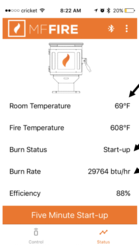A basic heat reclaimer can reduce draft, at the expense of dramatically increasing creosote accumulation. They are also butt ugly and noisy. The reclaimer that sadpanda describes is not too far from what MF Fire was testing, but with the upper thermocouple in the room IIRC. It's a costly setup.
I'm for any and ALL possible solutions...
The best most fool proof solution is the one with zero user intervention. Honestly given the 'variability' monster, every tool available should be fair game if the system is calibrated and validated.
Step 1 should be a simple draft evaluation, pipe diameter should be specified based on this calc. If that means 4in pipe on a 6in collar, so be it.
Step 2 stoves should have a barometric control to adjust for seasonal / burn cycle variance. A simple mechanical bimetallic spring can disable it if flue temps are too low and air can be pulled from the back side/top of the stove so its pre-heated.
Key damper and the rest should be available but avoided... How many times have you/wifey/spawn/newb forgotten to open the key damper(s?) before opening the door?
re: creosote forming on reclaimers... So what? If we are using dry wood, there should be no creosote and if we turn the stove down too far, the magic EPA honeycomb thingy is there to burn all the bad stuff away right? so again no problem. Even still, if creosote is likely to form anywhere it will be in the reclaimer tubes... Which normally have scrapers etc. If the reclaimer is emptied every load, whats the issue? What about building the reclaimer function into the stove? Aside from trying to simultaneously burn all of the hydrocarbons AND shoot them out the cap before they can condense, we don't need 600F air in the flue to generate sufficient draft (according to meaningless maths), so why not send it through some more steel/surface area and cool it off?
re: snorkeling the intake... I'm still waiting for the list perils and certain death



